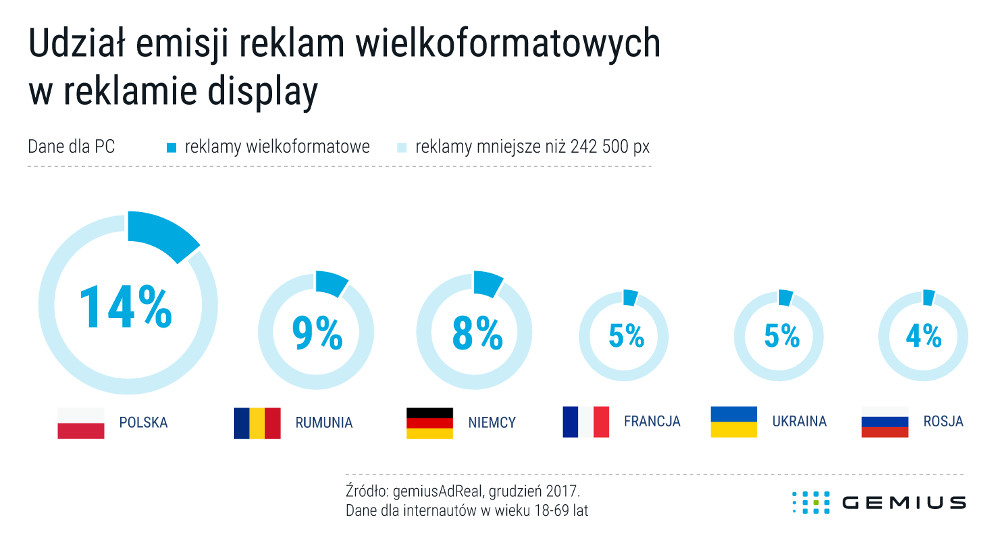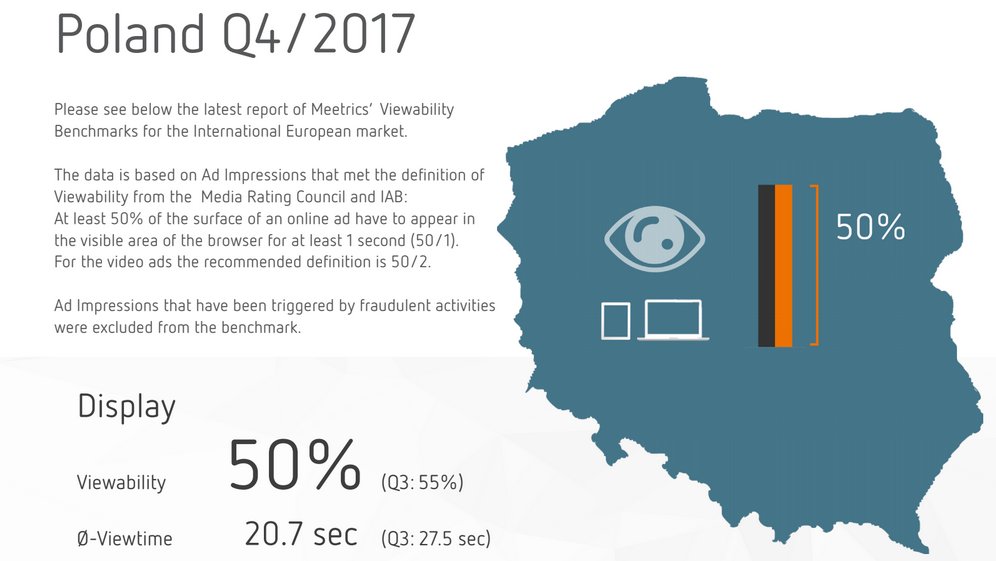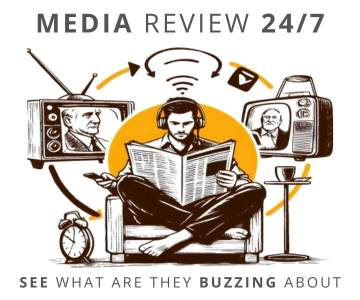 source: gemiusAdReal
source: gemiusAdRealAccording to gemiusAdReal data, one in seven ads displayed to Polish internet users is larger than 242,500 pixels. For comparison:
- In Romania, large-format ads make up 9% of the market,
- In Germany, they account for 8%,
- In France and Ukraine, only 5%.
At the same time, Poland ranks among the top countries where internet users block ads using ad-blockers. One in three internet users in Poland blocks ads, and according to data from 2017 published by Page Fair:
- 11% of internet users worldwide use ad-blockers,
- In 2017, ad-block usage increased by 30% worldwide.
Large-format ads have become a topic of public debate taken up by IAB Poland regarding setting visibility standards for online ads. In October of last year, viewability measurement recommendations were updated with specific guidelines for large display ads.
- The viewability standard for formats exceeding 242,500 pixels is 30% of the ad being visible for at least one continuous second.
- This is a lower threshold compared to other display and video ads, which must be at least 50% visible to be considered viewable.
Ad Visibility in Polish Online Space Declines
Meanwhile, as shown by Meetrics’ quarterly ad visibility studies, published for Q4 2017, visibility rates for display ads in Poland significantly declined. Compared to Q3, the display ad visibility rate fell by five percentage points, reaching 50% in Q4 (down from 55% in Q3). The average interaction time with display ads dropped to 20.7 seconds in Q4 (from 27.5 seconds in Q3).
 source: Viewability Benchmark Report 4Q2017, Meetrics
source: Viewability Benchmark Report 4Q2017, Meetrics- The drop in visibility rates clearly shows that while demand is rising dynamically, display ad resources are proving insufficient. Developing ad resources with greater viewability potential is a critical issue for the growth of the digital advertising market in Poland - commented Tomasz Piątkowski, Country Manager Poland at Meetrics. - It’s worth noting that 50% viewability means that exactly half of digital budgets were spent inefficiently in Poland in Q4.
The Future of Large-Format Ads
The future of large-format ads will also be affected by Google’s initiative to block ads in the Chrome browser that do not meet the standards set by the Coalition for Better Ads. This aims to enhance user comfort while browsing. Additionally, it is expected to reduce the demand for external ad-blocking software that blocks all ads on a given website.
- Changing standards in the online advertising market may certainly impact the viability of large-format ads. 2018 will show whether there is a place for them in this new landscape - comments Marta Wiercińska from Gemius.
Forecasts for the entire online advertising market aren’t always optimistic. The authors of the TMT Predictions 2018 report by Deloitte predict that by the end of 2018, half of all adults in developed countries will have at least two media subscriptions online. Consequently, some publishers are already viewing attempts to generate revenue from online ads as a waste of time.
COMMERCIAL BREAK
New articles in section Marketing and PR
Dance in the media mirror. Between culture, business and viral fame
KFi
Over 78,000 media pieces, 1.6 billion potential views, and 197,500 social media mentions-dance in Poland is no longer niche. With a combined media value exceeding PLN 800 million, it now outperforms MMA, handball, and hockey.
PR in Poland. Ranking of the largest public relations agencies 2025
KFi
The smallest teams often generate the most publications, and agencies outside Warsaw are increasingly capturing media attention. This unexpected distribution of power is one of the key findings from the 2025 PR Agency Ranking in Poland, developed by Widoczni and IMM.
Connected TV and borderless advertising. The ID5 report
KFi
Viewers are moving away from cable TV. And they are doing it en masse. Already 86% of Europeans watch content via Connected TV and global ad spend in this segment is set to double by 2028. The industry is undergoing a communication revolution.
See articles on a similar topic:
Child's sleepless nights? Educator suggests solutions for parents
patronat Reporterzy.info
Sleepless nights lead to fatigue, frustration, and worries about potential health issues for the child. Fortunately, most sleeping problems can be resolved by introducing appropriate habits and routines that help achieve a peaceful, restorative sleep.
Trends and threats in online advertising. Media Quality Report 2025
Krzysztof Fiedorek
In 2024, the digital advertising world lost about 100 billion dollars due to fake impressions. A report published by Integral Ad Science shows that so-called fraud is getting smarter, and campaigns are increasingly exposed.
When a Review Lies. The Growing Threat of Fake Opinions Online
KFi
Popularity of digital marketplaces rises, so does a less welcome trend: fake reviews. These manipulated opinions distort product rankings and mislead consumers, all while unfairly disadvantaging honest businesses. And despite regulatory efforts, the problem is far from solved.
What to do when a child bites nails? Advice from a child psychologist
patronat Reporterzy.info
For children, nail-biting is often a way to cope with boredom or stress. However, our role is to intervene when we notice this habit, not only for aesthetic reasons but also to address potential underlying causes. What might these be, and what can we do?






























